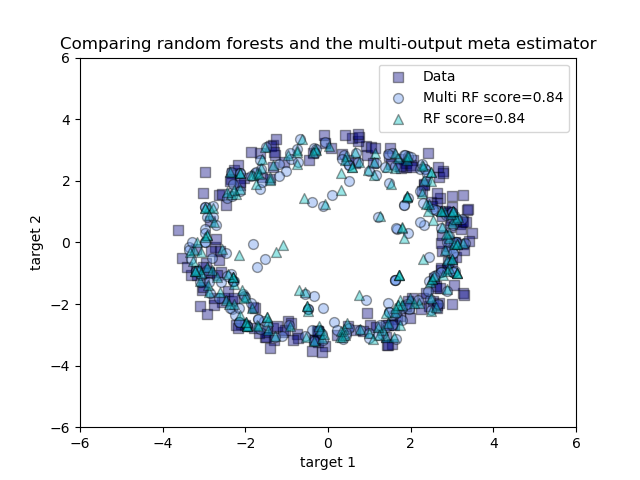sklearn.multioutput.MultiOutputRegressor¶
class sklearn.multioutput.MultiOutputRegressor(estimator, *, n_jobs=None)
[源码]
多目标回归
该策略包括为每个目标安装一个回归器。这是扩展本来不支持多目标回归的回归变量的简单策略。
版本0.18中的新功能。
| 参数 | 说明 |
|---|---|
| estimator | estimator object 实现拟合和预测的估计对象。 |
| n_jobs | int or None, optional (default=None) 为并行运行的作业数 fit。 None除非在joblib.parallel_backend上下文中,否则表示1 。 -1表示使用所有处理器。有关 更多详细信息,请参见词汇表。当各个估算器快速训练或预测使用 n_jobs>1时,由于生成过程的开销而导致性能降低。v0.20版中的更改: n_jobs默认从1更改为None |
| 属性 | 说明 |
|---|---|
| estimators_ | list of n_output estimators用于预测的估计量。 |
实例
>>> import numpy as np
>>> from sklearn.datasets import load_linnerud
>>> from sklearn.multioutput import MultiOutputRegressor
>>> from sklearn.linear_model import Ridge
>>> X, y = load_linnerud(return_X_y=True)
>>> clf = MultiOutputRegressor(Ridge(random_state=123)).fit(X, y)
>>> clf.predict(X[[0]])
array([[176..., 35..., 57...]])
| 方法 | 说明 |
|---|---|
fit(X, y[, sample_weight]) |
使模型拟合数据。 |
get_params([deep]) |
获取此估计量的参数。 |
partial_fit(X, y[, sample_weight]) |
使模型逐渐拟合数据。 |
predict(X) |
使用模型预测多输出变量 |
score(X, y[, sample_weight]) |
返回预测的确定系数R ^ 2。 |
set_params(**params) |
设置此估算量的参数。 |
__init__(estimator, *, n_jobs=None)
[源码]
初始化self, 请参阅help(type(self))以获得准确的说明。
fit(X, y, sample_weight=None, **fit_params)
[源码]
使模型拟合数据。为每个输出变量拟合一个单独的模型。
| 参数 | 说明 |
|---|---|
| X | (sparse) array-like, shape (n_samples, n_features) 数据。 |
| y | (sparse) array-like, shape (n_samples, n_outputs) 多输出目标。指标矩阵可打开多标签估计。 |
| sample_weight | array-like of shape (n_samples,), default=None 样本权重。如果为None,则对样本进行平均加权。仅当基础回归变量支持样本权重时才支持。 |
| **fit_params | dict of string -> object 参数传递给 estimator.fit每个步骤的方法。 |
| 返回值 | 说明 |
|---|---|
| self | object |
get_params(deep=True)
[源码]
获取此估计量的参数。
| 参数 | 说明 |
|---|---|
| deep | bool, default=True 如果为True,则将返回此估算器和作为估算器的所包含子对象的参数。 |
| 返回值 | 说明 |
|---|---|
| params | mapping of string to any 参数名称映射到其值。 |
partial_fit(X, y, sample_weight=None)
[源码]
使模型逐渐拟合数据。为每个输出变量拟合一个单独的模型。
| 参数 | 说明 |
|---|---|
| X | (sparse) array-like, shape (n_samples, n_features) 数据。 |
| y | (sparse) array-like, shape (n_samples, n_outputs) 多输出目标。 |
| sample_weight | array-like of shape (n_samples,), default=None 样本权重。如果为None,则对样本进行平均加权。仅当基础回归变量支持样本权重时才支持。 |
| 返回值 | 说明 |
|---|---|
| self | object |
predict(X)
[源码]
使用模型预测多输出变量
针对每个目标变量进行训练。
| 参数 | 说明 |
|---|---|
| X | (sparse) array-like, shape (n_samples, n_features) 数据。 |
| 返回值 | 说明 |
|---|---|
| y | (sparse) array-like, shape (n_samples, n_outputs) 跨多个预测变量预测的多输出目标。注意:为每个预测变量生成单独的模型。 |
score(X, y, sample_weight=None)
[源码]
返回预测的确定系数R ^ 2。
系数R ^ 2定义为(1- u / v),其中u是平方的残差和((y_true - y_pred) ** 2).sum(),而v是平方的总和 ((y_true - y_true.mean()) ** 2).sum(). 。可能的最高分是1.0,并且可能为负(因为该模型可能会更差)。不管输入特征如何,始终预测y的期望值的恒定模型将获得0.0的R ^ 2分数。
| 参数 | 说明 |
|---|---|
| X | array-like of shape (n_samples, n_features) 测试样本。对于某些估计量,这可能是一个预先计算的核矩阵或泛型对象列表,shape=(n_samples,n_samples_fitted),其中n_samples_fitted是在拟合估计器时使用的样本数。 |
| y | array-like of shape (n_samples,) or (n_samples, n_outputs) X的真实值。 |
| sample_weight | array-like of shape (n_samples,), default=None 样本权重 |
| 返回值 | 说明 |
|---|---|
| score | float self.predict(X) wrt. y.的R^2 |
注
调用score回归器时使用的R2得分multioutput='uniform_average'从0.23版开始使用 ,r2_score已与默认值保持一致。这会影响score所有多输出回归变量的方法(除外 MultiOutputRegressor)。
set_params(**params)
[源码]
设置此估算器的参数。
该方法适用于简单的估计器以及嵌套对象(例如 pipelines)。后者具有形式的参数, <component>__<parameter>以便可以更新嵌套对象的每个组件。
| 参数 | 说明 |
|---|---|
| **params | dict 估算量参数。 |
| 返回值 | 说明 |
|---|---|
| self | object 估算量实例。 |





